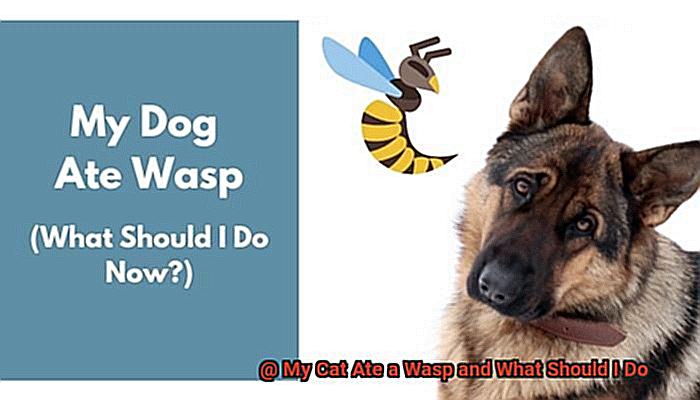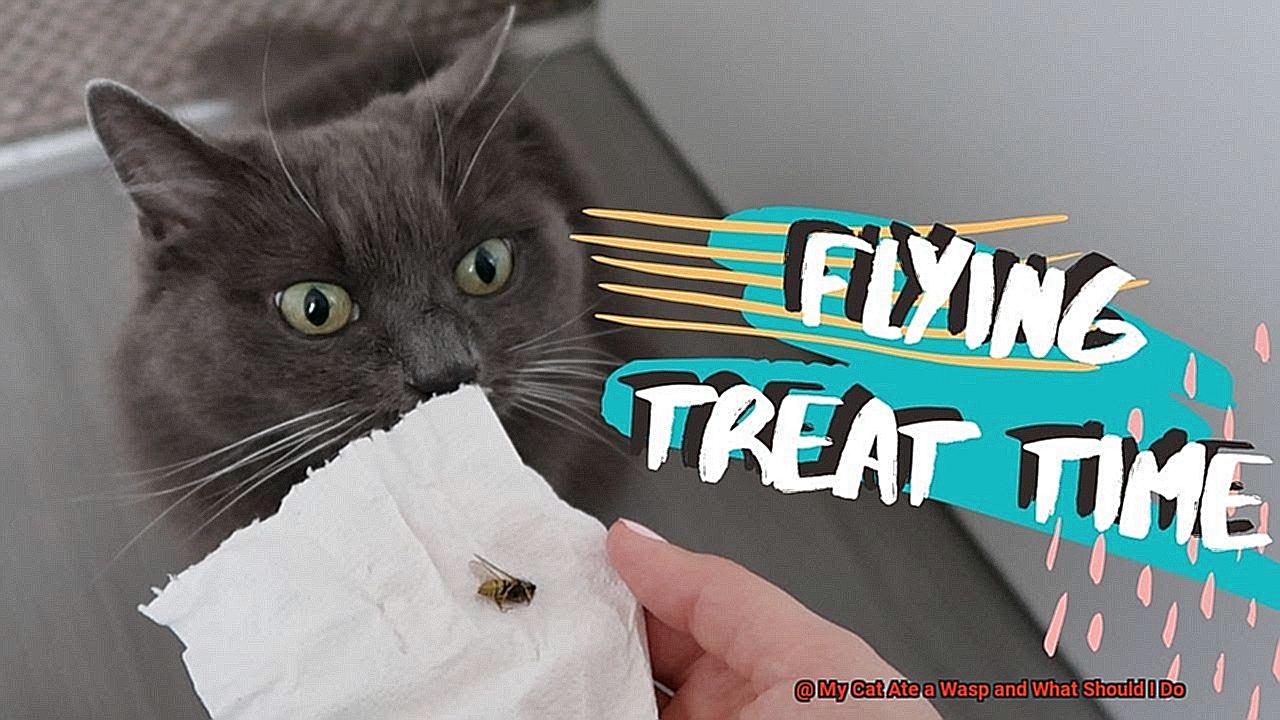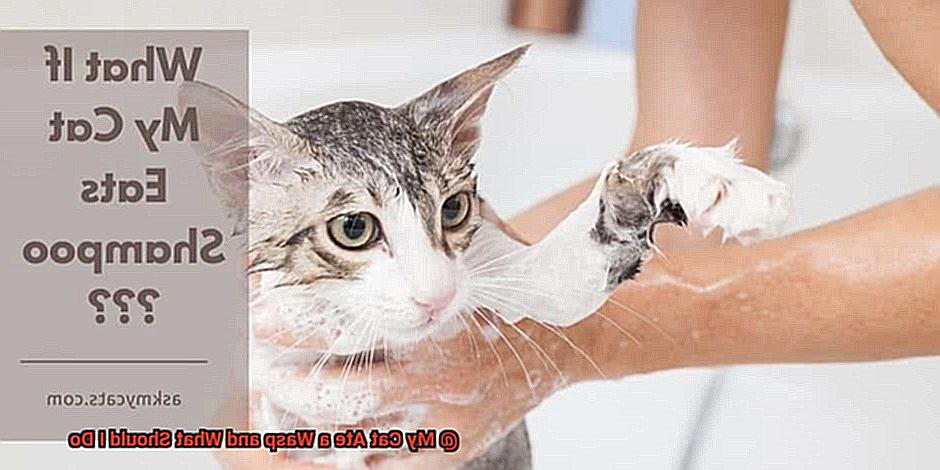It’s every pet owner’s worst nightmare – your furry friend chomping down on a wasp. The sound of the buzzing insect, the lightning-fast reflexes of your cat, and the ensuing panic can leave you feeling helpless and unsure of what to do next. Do you rush your cat to the vet or wait and see if any symptoms arise?
It’s important to understand that wasps can pose a serious threat to cats. Depending on the type of wasp and how much is ingested, your cat’s reaction can range from mild irritation to life-threatening symptoms like swelling, difficulty breathing, and anaphylactic shock.
In this blog post, we’ll delve into the topic of your cat eating a wasp and provide actionable steps to take next. We’ll explore common reactions cats have to wasp stings, how to monitor their symptoms, and when it’s time to seek veterinary care. Additionally, we’ll discuss preventative measures you can take to reduce the risk of future encounters between your cat and these pesky insects.
Whether you’re a seasoned cat owner or new to feline parenthood, this guide will equip you with everything you need to know about handling a situation where your cat has eaten a wasp. So sit tight as we walk you through this potentially stressful scenario with expert advice delivered in an engaging, professional tone that feels like a friendly conversation between friends.
What Happens When a Cat Eats a Wasp?
However, sometimes their curiosity can lead them down a dangerous path, especially when it comes to eating insects like wasps. While the idea of your cat munching on a wasp may seem harmless, the truth is that it can cause discomfort and even severe symptoms.

When a cat eats a wasp, the reaction can vary depending on the individual cat’s health and immune system. Typically, cats will experience mild symptoms such as drooling, pawing at the mouth, and shaking their head. However, some cats may have an allergic reaction to the wasp venom, which can lead to more severe symptoms such as breathing difficulties, swelling, and even anaphylactic shock.
It’s important to keep in mind that not all wasps are created equal. Some species of wasps are more venomous than others, and the amount of venom injected into the cat’s body can also affect the severity of the reaction. Additionally, if the wasp is ingested whole, it may cause irritation or injury to the cat’s digestive system.
If you suspect that your cat has eaten a wasp, it’s crucial to monitor them closely for any signs of distress or discomfort. If your cat is exhibiting mild symptoms like drooling or pawing at their mouth, you can try rinsing their mouth with water or offering them a small amount of milk to help neutralize the venom.
However, if your cat is experiencing more severe symptoms like difficulty breathing or swelling, it’s vital to seek veterinary care immediately. Your vet may administer antihistamines or steroids to reduce inflammation and manage allergic reactions. In some cases, your cat may require hospitalization for observation and supportive care.
Prevention is key when it comes to keeping your cat safe from wasp stings. Avoid leaving food outside for extended periods of time, as this can attract wasps. Additionally, if you notice a wasp nest in your yard, it’s best to have it removed by a professional to prevent your cat from accidentally ingesting a wasp.
Symptoms of Wasp Stings in Cats
Wasp stings in cats can be a real buzzkill, causing a range of symptoms from mild discomfort to severe allergic reactions. As an expert on this topic, let me guide you through the signs and symptoms of wasp stings in cats so that you can identify them quickly and help your furry friend get the care they need.
One of the most common symptoms of a wasp sting in cats is pain or discomfort. Your cat may vocalize their discomfort, lick or bite at the area of the sting, or show reluctance to move or play. You may also notice swelling or redness at the site of the sting, indicating inflammation.
For some cats, wasp venom can trigger an allergic reaction. If your cat is allergic, they may experience more severe symptoms like difficulty breathing, swelling in the face or throat, vomiting, diarrhea or even collapse. In such cases, it’s crucial to seek veterinary care immediately to prevent further complications.
Cats that are stung multiple times may also experience more severe symptoms like fever or lethargy. In rare cases, a cat may develop a systemic reaction to a wasp sting, which can be life-threatening if left untreated.

It’s important to monitor your cat closely if they have been stung by a wasp and contact your veterinarian if you notice any concerning symptoms. Remember that prevention is key to avoiding wasp stings in cats. Keep your cat indoors during peak wasp activity times and inspect outdoor areas for nests or hives.
Seeking Veterinary Care for Wasp Stings in Cats
Unfortunately, wasp stings can pose a significant danger to your feline companion, especially if they’re allergic to the venom. If you suspect your cat has been stung by a wasp, it’s crucial to seek veterinary care as soon as possible.
Wasp stings can cause a variety of symptoms in cats, including swelling, redness, pain, and itching. In severe cases, an allergic reaction may result in difficulty breathing or even collapse. If you notice any of these symptoms in your cat, don’t hesitate to contact your veterinarian immediately – this could be a life-threatening emergency.
Even if your cat seems okay after eating a wasp, it’s still a good idea to consult with your vet. They may recommend bringing your cat in for an exam to ensure that there are no complications. Your vet will determine the best course of treatment based on the severity of your cat’s reaction – this may include antihistamines, steroids, or epinephrine injections.
In addition to immediate treatment, your veterinarian may also recommend allergy shots or medication to help manage future symptoms and prevent future allergic reactions. It’s important to note that home remedies like applying ice or baking soda to the sting site may do more harm than good. Always consult with your vet before trying any home remedies.
Treating Wasp Stings at Home
That’s why knowing how to treat wasp stings at home is an important skill to have. A wasp sting can be a real buzzkill for your cat, causing pain, swelling, and itching. In severe cases, it can even lead to life-threatening allergic reactions.
Before attempting any home remedies, it’s crucial to assess the severity of the sting. If your cat is showing signs of an allergic reaction such as difficulty breathing or swelling in the face or throat, don’t hesitate to seek immediate veterinary attention.
If the sting is not severe, you can take the following steps to alleviate your cat’s discomfort:
Step 1: Remove the Stinger
The first step is to remove the stinger if it’s still visible in the skin. Use a credit card or similar object to scrape it out carefully without squeezing it.
Step 2: Apply a Cold Compress

Next, apply a cold compress to the affected area for 10-15 minutes at a time. You can use a bag of frozen peas wrapped in a towel or a cold, damp cloth. This will help reduce swelling and pain.
Step 3: Make a Baking Soda Paste
If your cat is experiencing itching or discomfort from the sting, you can try making a baking soda paste. Mix equal parts baking soda and water to create a paste and apply it to the skin. Leave it on for 10-15 minutes before rinsing off with warm water.

Step 4: Monitor for Further Complications
After treatment, keep an eye on your cat for any signs of further complications such as vomiting or diarrhea. If these symptoms persist or worsen after a few hours, seek veterinary attention.
Prevention Tips for Keeping Cats Safe from Wasps
During the summer months, wasp stings can pose a danger to your cat’s health and well-being. However, there are several steps you can take to prevent your cat from getting stung in the first place.
Keep Your Cat Indoors
The easiest way to protect your cat from wasp stings is to keep them indoors as much as possible. This will not only protect them from wasp stings but also from other outdoor hazards such as traffic accidents and fights with other animals. If your cat does go outside, make sure they are supervised at all times and keep them on a leash or in an enclosed area.
Cover Food and Drinks
Wasps are attracted to sweet smells, so make sure to cover your cat’s food and water bowls when they are not being used. This will help to prevent wasps from being attracted to the area and potentially stinging your cat.
Keep Garbage Bins Sealed

Wasps are also attracted to garbage, so make sure to keep all garbage bins sealed tightly. This will help to prevent wasps from being attracted to the area and potentially stinging your cat.
Plant Cat-Safe Plants
Certain plants like lemon balm, lavender, and mint can help repel wasps. Planting these around your home can help keep wasps away and keep your cat safe.
Use Natural Repellents
You can also use natural repellents like citronella oil or vinegar spray around your home to repel wasps. Just make sure that these are safe for cats before using them.
By following these prevention tips, you can help ensure that your cat stays safe from wasp stings. However, if you do notice any signs of an allergic reaction or if your cat has eaten a wasp, it’s important to seek veterinary care immediately.
asEKIRwV6nc” >
Conclusion
To sum it up, wasp stings can be a real pain for your furry friend. If your cat has eaten a wasp or been stung by one, keep an eye on their symptoms and seek veterinary care if necessary. Simple remedies like rinsing the mouth with water or applying a cold compress can help with mild symptoms such as drooling or pawing at the mouth. However, more severe symptoms like difficulty breathing or swelling require immediate attention from a veterinarian.
Prevention is key when it comes to keeping your cat safe from wasp stings. You can reduce the risk of encounters between your cat and these pesky insects by following simple tips like keeping your cat indoors during peak wasp activity times, covering food and drinks, and planting cat-safe plants around your home.
Don’t forget that even if your cat seems fine after eating a wasp or being stung, consulting with your vet is always a good idea. They may recommend bringing your cat in for an exam to ensure that there are no complications.







